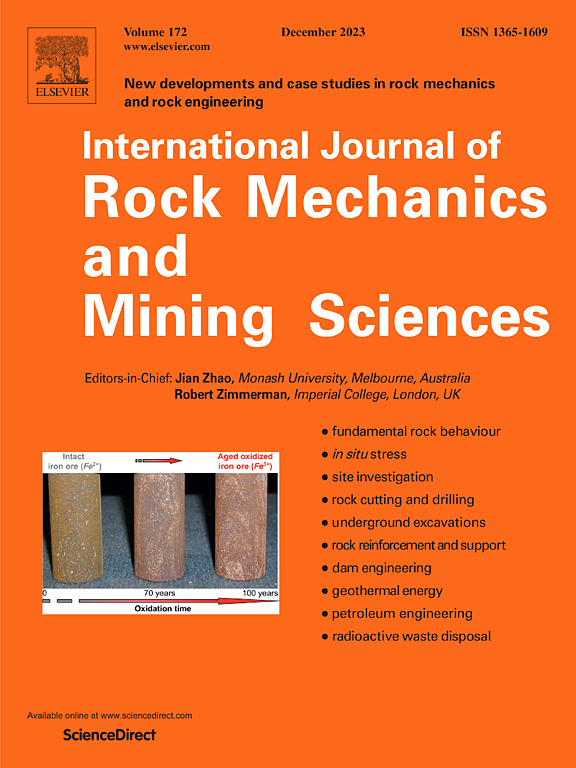二维爆破拉伸断裂特征与定向破裂机理:实验研究与理论建模
IF 7
1区 工程技术
Q1 ENGINEERING, GEOLOGICAL
International Journal of Rock Mechanics and Mining Sciences
Pub Date : 2025-02-15
DOI:10.1016/j.ijrmms.2025.106059
引用次数: 0
摘要
爆破是岩土工程中破岩的一项关键技术,定向裂缝控制爆破是其最重要的应用之一。为了推动这一领域的发展,一种新的非炸药爆破方法——二维爆破(2D爆破)被开发出来。这项创新技术利用膨胀剂产生的高温高压气体,沿井壁劈裂方向诱发拉应力,促进岩体定向破裂。二维爆破定向破裂机理的研究和理论建模极具挑战性,但这对二维爆破技术的现场应用和参数设计至关重要。在本研究中,对混凝土试件进行了二维爆破和常规爆破的对比试验。用高速摄像机记录了动态裂纹扩展行为,并用数字图像相关(DIC)方法分析了拉伸断裂特征。实验结果表明,常规爆破在钻孔周围产生随机、无序的径向裂缝,形成三维裂缝网络。而二维爆破采用能量聚集装置调节井壁应力分布,将三维裂缝网络按预定方向转化为二维裂缝面。基于这些实验结果,建立了常规爆破和二维爆破的力学模型。分析了二维爆破条件下井壁周围的应力集中效应,提出了二维爆破条件下裂缝起裂和扩展的判据。研究结果证实了2D爆破的定向压裂效果,表征了其拉伸破裂行为,并对其潜在机制提供了有价值的见解,为定向裂缝控制爆破技术的进一步发展提供了参考。本文章由计算机程序翻译,如有差异,请以英文原文为准。
Tensile fracture characteristics and directional fracturing mechanism of 2D blasting: Experimental investigation and theoretical modelling
Blasting is a crucial technique for rock breaking in geotechnical engineering, with directional fracture-controlled blasting being one of its most important applications. To advance this field, a novel non-explosive blasting method, termed two-dimensional blasting (2D blasting), has been developed. This innovative technique utilizes high-temperature, high-pressure gas generated by expansion agent to induce tensile stress along the splitting direction of the borehole wall, facilitating directional rock mass rupture. The research and theoretical modelling of the directional fracturing mechanism for 2D blasting are extremely challenging, but this is crucial for the field application and parameter design of 2D blasting technology. In this study, comparative experiments were conducted using concrete specimens subjected to both 2D and conventional blasting. Dynamic crack propagation behaviour was recorded with a high-speed camera, and tensile fracture characteristics were analysed using the Digital Image Correlation (DIC) method. The experimental results revealed that conventional blasting generates random, disordered radial cracks around the borehole, forming a three-dimensional (3D) fracture network. In contrast, 2D blasting employs an energy-gathering device to regulate stress distribution on the borehole wall, transforming the 3D fracture network into a two-dimensional (2D) fracture plane in the preset direction. Building on these experimental findings, mechanical models for both conventional and 2D blasting were established. The stress concentration effects around the borehole wall under 2D blasting were analysed, and criteria for crack initiation and propagation in 2D blasting were proposed. The results confirmed the directional fracturing efficacy of 2D blasting, characterized its tensile fracture behaviour, and provided valuable insights into its underlying mechanisms, offering a reference for further advancements in directional fracture-controlled blasting technologies.
求助全文
通过发布文献求助,成功后即可免费获取论文全文。
去求助
来源期刊
CiteScore
14.00
自引率
5.60%
发文量
196
审稿时长
18 weeks
期刊介绍:
The International Journal of Rock Mechanics and Mining Sciences focuses on original research, new developments, site measurements, and case studies within the fields of rock mechanics and rock engineering. Serving as an international platform, it showcases high-quality papers addressing rock mechanics and the application of its principles and techniques in mining and civil engineering projects situated on or within rock masses. These projects encompass a wide range, including slopes, open-pit mines, quarries, shafts, tunnels, caverns, underground mines, metro systems, dams, hydro-electric stations, geothermal energy, petroleum engineering, and radioactive waste disposal. The journal welcomes submissions on various topics, with particular interest in theoretical advancements, analytical and numerical methods, rock testing, site investigation, and case studies.

 求助内容:
求助内容: 应助结果提醒方式:
应助结果提醒方式:


